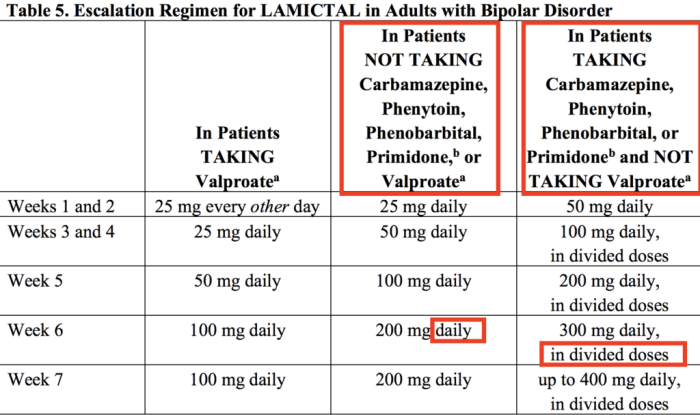Choose the appropriate statement regarding lamotrigine dosing – Lamotrigine dosing is a crucial aspect of its therapeutic use, requiring careful consideration to ensure optimal outcomes. This article delves into the intricate parameters, specific conditions, and factors influencing lamotrigine dosing, empowering healthcare professionals with the knowledge to tailor treatment regimens for each patient.
Lamotrigine, an anticonvulsant and mood stabilizer, has gained prominence in treating various neurological and psychiatric conditions. Its efficacy is contingent upon appropriate dosing, which encompasses a range of considerations, including the patient’s age, weight, hepatic function, and concomitant medications.
Lamotrigine Dosing Parameters

Lamotrigine is an anticonvulsant medication used to treat epilepsy and bipolar disorder. The dosing of lamotrigine is individualized based on several factors, including age, weight, and concomitant medications.
Typical Starting Dose, Choose the appropriate statement regarding lamotrigine dosing
The typical starting dose of lamotrigine for adults is 25 mg once daily. The dose may be gradually increased by 25-50 mg every 1-2 weeks until the desired therapeutic effect is achieved or the maximum daily dose is reached.
Recommended Titration Schedule
The recommended titration schedule for lamotrigine is as follows:
- Week 1: 25 mg once daily
- Week 2: 50 mg once daily
- Week 3: 100 mg once daily
- Week 4: 150 mg once daily
- Week 5: 200 mg once daily
- Week 6: 250 mg once daily
Maximum Daily Dose
The maximum daily dose of lamotrigine is 500 mg.
Expert Answers: Choose The Appropriate Statement Regarding Lamotrigine Dosing
What is the typical starting dose of lamotrigine?
The typical starting dose of lamotrigine is 25 mg once daily, which may be increased gradually as tolerated.
How should lamotrigine dosing be adjusted based on therapeutic response?
Lamotrigine dosing should be adjusted based on therapeutic response and adverse effects. If the patient is not responding adequately, the dose may be increased gradually. If adverse effects occur, the dose may need to be decreased.
What are the potential adverse effects of lamotrigine?
The potential adverse effects of lamotrigine include dizziness, nausea, vomiting, headache, and rash. In rare cases, lamotrigine can cause serious adverse effects such as Stevens-Johnson syndrome and toxic epidermal necrolysis.


